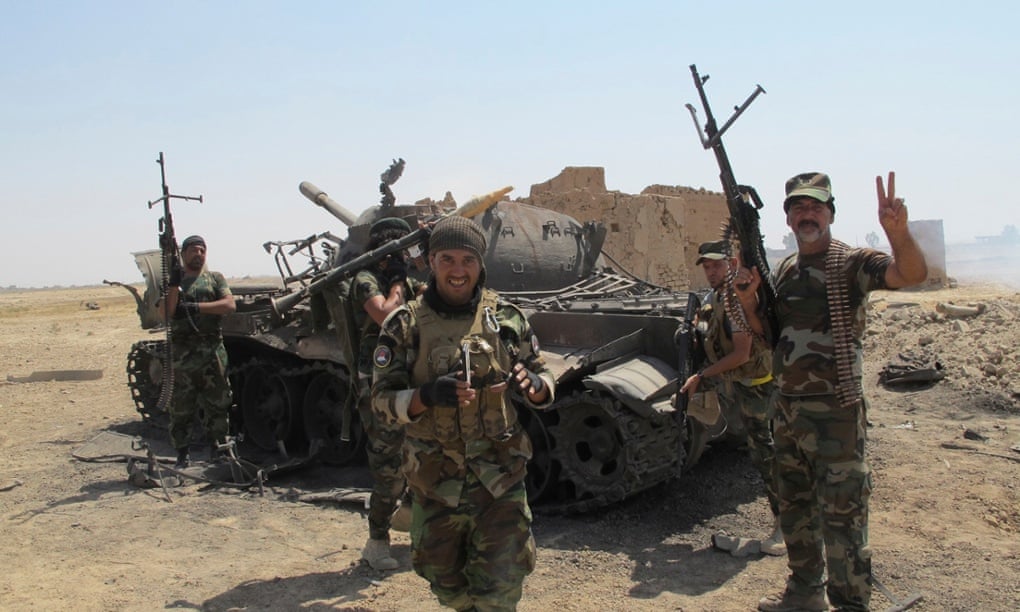Push to retake areas held by Islamic State leaves minority Sunnis at risk of becoming human shields or victims of revenge-seeking Shia militia The large-scale offensive by the Iraqi army and Shia militias against Islamic State (Isis) forces has ignited fears of renewed atrocities and “human shield” kidnappings directed against minority Sunnis, who are reportedly fleeing Tikrit and other targeted cities in large numbers.
The large-scale offensive by the Iraqi army and Shia militias against Islamic State (Isis) forces has ignited fears of renewed atrocities and “human shield” kidnappings directed against minority Sunnis, who are reportedly fleeing Tikrit and other targeted cities in large numbers.
The offensive, launched early on Monday in Salahuddin province, north of Baghdad, is intended to capitalise on recent reverses suffered by Isis, and clear a path for the eventual reconquest of Mosul and northern Iraq.
But the rush to punish Isis, enthusiastically egged on by the US and Britain, poses new risks for vulnerable Sunnis living in an area that was notoriously violent during the American occupation – the Sunni triangle, extending west from Baghdad to Ramadi and north to Tikrit.
According to reports reaching the Institute for the Study of War from Tikrit on Sunday, most residents who can afford it have already begun to flee north to Mosul and east to Kirkuk, with only the poorest left behind. Isis fighters, meanwhile, were said to be holding “an unspecified number of civilians as human shields” in Tikrit and other cities.
Western analysts are also worried the offensive could further strengthen Iran’s formidable grip on Iraq’s government and security forces at a time when Tehran seems poised to make a strategic breakthrough by cutting a historic nuclear deal with the west.
Predominantly Shia Muslim Iran has long aided and abetted Iraq’s Shia militias, notably the Badr Organisation (formerly the Badr Brigades), whose political wing was formerly the Tehran-allied Supreme Council for Islamic Revolution in Iraq. Shia militias have been accused of perpetrating atrocities against Sunni civilians in the period following the US withdrawal in 2011. In one notorious case in January, witnesses said 72 unarmed Sunnis were shot dead by Shia militia in the village of Barwana, Diyala province.
Shia volunteer militias from the so-called Popular Mobilisation units are in the vanguard of Monday’s offensive, which Iraqi officials said involved 30,000 regular army, special forces, police and volunteers.
Former Shia prime minister Nouri al-Maliki, blamed by the Obama administration for exacerbating sectarian divisions, began incorporating Shia militias into the security forces in August 2013. The practice accelerated under his successor, Haider al-Abadi, who has vowed to do more to bridge the Sunni-Shia divide.
But analysts say that while the wished-for process of political reconciliation has faltered, the Shia militias, with active Iranian support and direction, are taking the lead in the fight against Isis and in the larger battle to reunify Iraq. “It’s increasingly difficult to tell where the Iraqi army ends and the Iranian-supported Shia militias begin,” wrote Bloomberg columnist Eli Lake.
Hadi al-Amiri, leader of the Badr Organisation, told Lake that the US had recently offered air strikes to support the ground forces under his command – a controversial offer, if true. He said he also had significant Iranian backing.
According to Iraqi and Iranian media, Qassem Suleimani, commander of the al-Quds force covert operations branch of Tehran’s Revolutionary Guards, is currently in Salahuddin to help coordinate the new offensive. His involvement is nothing new. As far back as 2008, American commanders were aware of Suleimani’s murky influence in Iraq.
Amiri told Lake he often met Suleimani in Baghdad. “He advises us. He offers us information, we respect him very much,” he said. “No country has experience likeIran in dealing with terrorists.” Lebanon’s Hezbollah had also provided the Badr Organisation with important lessons learned from fighting Israel and Sunni jihadis in Lebanon and Syria.
“The government’s security forces, both army and police, are overwhelmingly Shia,” said American analyst Kenneth Pollack. “Many of Iraq’s recent conquests were won by Iranian-backed Shia militias. The government does not like to admit it, but these militias often lead Iraqi attacks and form the backbone of their defences.
“In these circumstances, offensive operations into the Sunni heartland – Anbar, Nineveh and Salahuddin provinces – could be disastrous. The Sunni populace is terrified by reports of Shia troops and militiamen conducting brutal ethnic cleansing operations … The Sunnis may well see Iraqi government forces (and even the Kurds) not as liberators, but as a conquering Shia army,” Pollack said.
Abadi is clearly worried about possible atrocities, especially after Amiri, speaking at the weekend, urged Tikrit residents to flee their homes so his forces could “wrap up the battle of the revenge for Speicher”.
Speicher is a military base near Tikrit from which hundreds of Shia recruits were kidnapped and killed last summer by Isis. Shia militias have vowed revenge, sparking fears of mass killings of Sunnis if Tikrit is recaptured. “The priority we gave to the armed forces and all the forces taking part alongside them is to preserve the security of citizens,” Abadi said in Samarra. The utmost care should be taken to protect civilian lives and property, he added. But as war once again sweeps through the Sunni triangle, Abadi’s words may not carry much weight.
































